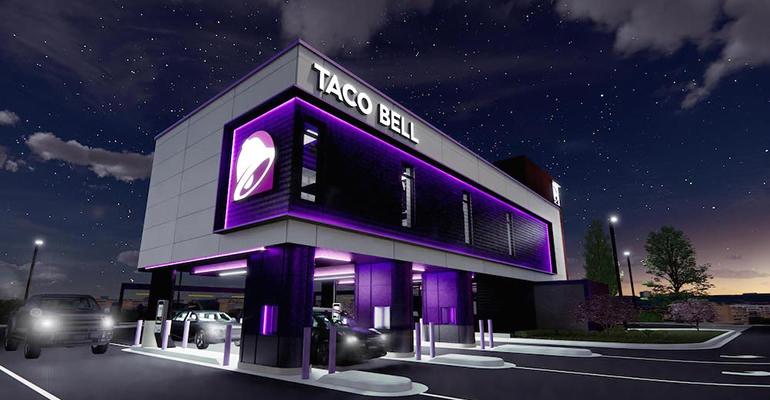On paper, there aren’t too many similarities between Taco Bell and McDonald’s. Sure, both brands are quick-service juggernauts that rely heavily on loyalists, brand marketing and digital prowess to drive their heavily franchised systems. But McDonald’s is much, much bigger, with nearly twice as many U.S. restaurants. It’s also the unquestionable market share leader in a very intense burger segment, while Taco Bell sits atop a significantly less crowded Mexican category.
That said, everything is relative in the competition over share of stomach. And so, when it comes to Taco Bell’s domestic potential, McDonald’s seems to be the benchmark. During Yum Brands’ Investor Day event in New York City Tuesday, Taco Bell CEO Mark King discussed several opportunities for his brand heading into 2023, including daypart and unit count opportunities. In both of those cases, he cited McDonald’s as the gauge.
“The perception of Taco Bell in terms of pricing is we’re the leader in value and it’s important to maintain that. Mas occasions is the biggest opportunity for us to grow. Our competitors have way more reasons to go to them, specifically McDonald’s,” King said, citing “dayparts, coffee and treats” as examples.
King noted that the breakfast and lunch dayparts are “significantly” behind McDonald’s, while dinner and late-night dayparts are more on par. One potential solution to close this gap is to bring fries to the menu permanently versus via Taco Bell’s current limited-time offer strategy.
“It’s our belief this will increase lunch dramatically,” King said. “People who go to lunch want fries.”
McDonald’s is also a target for breakfast and King said Taco Bell has to change its strategy to compete in this highly profitable daypart.
“We’ve been in and out of breakfast for seven years. It’s time to commit to it – in product, marketing, communication, understanding what consumers want,” King said. “We are committed to closing both of those gaps. There are big opportunities just in those two dayparts to increase in the coming years.”
What that means for the menu, in addition to permanent fries, is more desserts (King teased ice cream as an example) and beverage innovation. Taco Bell is currently testing several iced coffee options, for example, that could drive more frequency in the morning. He added that chicken is also a big opportunity.
“A large percentage of our business is beef, and the Gen Z consumer wants chicken,” he said.
Taco Bell is also aiming at a bigger domestic footprint, aiming once again at its QSR peer.
“It’s a big aspiration – McDonald’s has about 13,000 and we have over 7,000. We believe as we grow our (average unit volumes) and our margin stays strong, there is no reason we can’t have that same number,” King said.
It’s worth noting that Taco Bell is very much an industry benchmark on its own, however, particularly when considering its margins, which are near 25%.
King said the “secret to those margins” is the chain leaning into dynamic pricing between three buckets – the 75% of consumers who are willing to pay a little more for their favorite product, the everyday value menu items, and the innovation items that generate about 15% of transactions.
“Our ability to move pricing between those three buckets, taking more pricing where consumers are willing to pay more, allows us to bring consumers in and still have a value perception but maintain those great margins,” he said.
King expects Taco Bell’s momentum to continue, driven in large part by its digital initiatives and its marketing muscle. Currently, Taco Bell’s digital sales make up about 23% of the mix, which is below Yum Brands’ 40% overall mix, illustrating the potential to ramp up those sales. The chain will lean into its kiosk, web and app presence to do so, with a sharpened focus on its recently iterated loyalty program.
It will also focus on generating buzz – building on the past few years of “big moments” like the launch of the Taco Bell Hotel & Resort, the Super Bowl campaign, the Mexican Pizza campaign, the opening of the Defy Restaurant in Minneapolis and more.
“Three years ago, this formula looked very different. It was value and drive-thru time. Now there’s this idea of brand buzz. What we’ve learned is value drives transactions, but big moments create buzz and transactions,” King said. “We used to have a calendar of being on TV. Now we have a calendar of being on TV and creating events and moments.”
King said Taco Bell will have 12 of those moments in 2023.
“This has been a big learning for us – our core consumer, Gen Z, they don’t watch a lot of TV,” he added. “How do we connect with our core consumer? This learning is the evolution of how we market our brand to our base, so it’s a big deal for us.”
Contact Alicia Kelso at [email protected]

